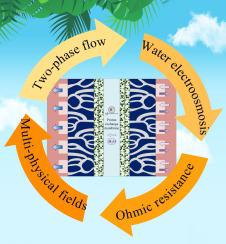当前位置:
X-MOL 学术
›
Energy Convers. Manag.
›
论文详情
Our official English website, www.x-mol.net, welcomes your feedback! (Note: you will need to create a separate account there.)
Performance modeling and mechanism study of proton exchange membrane water electrolyzer coupled with water electroosmosis
Energy Conversion and Management ( IF 9.9 ) Pub Date : 2024-07-03 , DOI: 10.1016/j.enconman.2024.118753 Jingxian Chen , Yongwen Sun , Ding Hu , Han Yao , Xiaojun Shen , Cunman Zhang , Hong Lv
Energy Conversion and Management ( IF 9.9 ) Pub Date : 2024-07-03 , DOI: 10.1016/j.enconman.2024.118753 Jingxian Chen , Yongwen Sun , Ding Hu , Han Yao , Xiaojun Shen , Cunman Zhang , Hong Lv

|
Proton exchange membrane water electrolyzers are highly promising green and high-purity hydrogen production devices. Cell performance and characteristic distribution are influenced by complex multiphysics processes, such as two-phase flow and water electroosmosis; however, detailed mechanistic analyses and influencing factors have not been thoroughly studied. A three-dimensional full-scale two-phase model, which couples the hydrodynamics, electrochemical reaction kinetics, mass and heat transfer, two-phase flow based on capillary pressure, and water electroosmosis, was developed and verified using experimental data in this study. The effects of cell voltage on heat and mass distribution were discussed in detail for multiple coupled physical processes. Three crucial parameters, porous transport layer porosity, thickness, and membrane type, were investigated regarding their effects on the characteristic distribution and cell performance. Finally, an ohmic resistance analysis was conducted to investigate the impact of the physical properties of the material. The results show that the increased porosity and decreased thickness of porous transport layer positively improved the mass transport and current density and decreased interfacial contact resistance. Consequently, the water discharge in the cathode was improved accordingly. Moreover, the membrane type is closely related to water electroosmosis owing to the different electroosmosis coefficients, and the reduced membrane thickness decreased the proton exchange membrane resistance. This study lays the foundation for further mechanistic analyses of mass and heat transfer, water management on the cathode side, and performance optimization in electrolyzer.
中文翻译:

质子交换膜水电解槽与水电渗耦合性能建模及机理研究
质子交换膜水电解槽是极具前景的绿色高纯度制氢装置。电池性能和特性分布受到复杂的多物理过程的影响,例如两相流和水电渗;然而,详细的机制分析和影响因素尚未得到深入研究。本研究开发并利用实验数据验证了三维全尺寸两相模型,该模型耦合了流体动力学、电化学反应动力学、传质和传热、基于毛细管压力的两相流和水电渗。详细讨论了多个耦合物理过程的电池电压对热量和质量分布的影响。研究了多孔传输层孔隙率、厚度和膜类型这三个关键参数对特征分布和电池性能的影响。最后,进行欧姆电阻分析以研究材料物理性能的影响。结果表明,多孔传输层孔隙率的增加和厚度的减小积极改善了质量传输和电流密度,并降低了界面接触电阻。因此,阴极中的水排放相应地得到改善。此外,由于电渗系数不同,膜类型与水电渗密切相关,膜厚度的减小会降低质子交换膜的电阻。该研究为进一步传质传热机理分析、阴极侧水管理以及电解槽性能优化奠定了基础。
更新日期:2024-07-03
中文翻译:

质子交换膜水电解槽与水电渗耦合性能建模及机理研究
质子交换膜水电解槽是极具前景的绿色高纯度制氢装置。电池性能和特性分布受到复杂的多物理过程的影响,例如两相流和水电渗;然而,详细的机制分析和影响因素尚未得到深入研究。本研究开发并利用实验数据验证了三维全尺寸两相模型,该模型耦合了流体动力学、电化学反应动力学、传质和传热、基于毛细管压力的两相流和水电渗。详细讨论了多个耦合物理过程的电池电压对热量和质量分布的影响。研究了多孔传输层孔隙率、厚度和膜类型这三个关键参数对特征分布和电池性能的影响。最后,进行欧姆电阻分析以研究材料物理性能的影响。结果表明,多孔传输层孔隙率的增加和厚度的减小积极改善了质量传输和电流密度,并降低了界面接触电阻。因此,阴极中的水排放相应地得到改善。此外,由于电渗系数不同,膜类型与水电渗密切相关,膜厚度的减小会降低质子交换膜的电阻。该研究为进一步传质传热机理分析、阴极侧水管理以及电解槽性能优化奠定了基础。












































 京公网安备 11010802027423号
京公网安备 11010802027423号